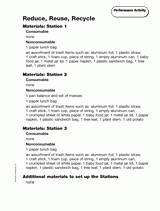Americans produce a lot of trash, there's no question about it. The amount of stuff we throw away in this country is staggering.
The U.S. Environmental Protection Agency estimates that Americans generate about 4.6 pounds of trash per person-every day. Forty years ago, each person produced only 2.7 pounds each day.
There are nearly 300 million people in the United States. You do the math. Is it any wonder our landfills are filling up faster than we can figure out what to do about it?
As you can imagine and probably know, trash is a weighty (no pun intended) topic in this country. With only so much landfill space available, scientists and environmentalists are looking to other means of disposing of trash, such as burning it. We all, however, can help cut back on the amount of trash we generate by keeping in mind the motto of environmentalists-reduce, reuse, and recycle.
In addition to the amount of trash we produce as individuals and as a country, how we dispose of it is another problem. The plastic bags that most of us place outside of our homes to be hauled off to landfills every week are not exactly what you'd call environmentally friendly.
Nobody knows for sure how long regular plastic bags take to totally degrade, or break down, in a landfill, because we've only been using plastic commercially for about 90 years. It's estimated, however, that it may take 100 years for a plastic bag to completely degrade. It's sort of depressing to think that a plastic bag can outlive the majority of people on the planet.
In this section, we'll look at several types of bags and try to determine which ones break down faster when dumped into a landfill. Once you know, you can become an environmental ranger and start encouraging everyone around you to use the most environmentally friendly bag.
So What Seems to Be the Problem?
The problem on a large scale, as stated above, is that we generate too much trash in this country, and much of it is material that will take many, many years to degrade.
To solve this problem, we've got to learn to produce less trash, and to produce trash that won't stick around so long.

The problem you'll be attempting to solve in the course of this science fair project is related to the second part of the equation above. In addition to producing less trash, we've got to cut the time that it takes for our trash to degrade. Your task in this project is to test different types of trash bags, and determine which type of bag is the most biodegradable.
It makes sense, doesn't it, to use trash bags that break down as quickly as possible, thereby allowing whatever is inside of them to degrade, as well.
Some manufacturers have come up with plastic bags that they claim are biodegradable, and some people use paper bags to hold their trash. Most folks, however, happily fill up one plastic trash bag after another, causing our landfills to be inundated with the long-lasting material.
- Paper grocery bag
- Plastic grocery bag
- Standard trash bag
- Plastic trash bag labeled as biodegradable
This experiment will give you an idea of how fast these bags might break down in a landfill.
If you want, you can use the title of this section, "What Kind of Trash Bag Breaks Down Fastest?" for the title of your science fair project. Other titles you might consider are:
- Paper or Plastic, What's Best For the Earth?
- Best Bets for Bagging Your Trash
- Making a Biodegradable Choice
Once you've chosen a title for your project, let's move along and have a look at what the purpose of such an undertaking might be.
What's the Point?
The environment is a hot topic these days, and kids are getting involved in all sorts of projects and movements to help save it.
There are groups of kids and young adults working to save rainforests, animals, and waterways. Kids have formed recycling awareness groups in their schools and neighborhoods, often serving as a community conscience.
Seeing firsthand what happens to trash bags when they're buried will give you knowledge and help you to make informed decisions about what type of bags are best for you and your family to use for your trash. Once you know how the different bags degrade, you can tell others. You could even start a movement in your neighborhood to use bags that are easier on Mother Earth.
What Do You Think Will Happen?
You may already have a strong feeling about what will happen to different kinds of bags when they're buried in your yard. You've probably handled enough paper and plastic to know what happens when they get wet, or how they withstand heat and cold.
From reading or hearing about environmental problems associated with plastic, you probably have the idea that paper is more environmentally friendly. But, what about plastic that is made to be environmentally friendly? Do you have an idea how that might compare to paper? Or to regular plastic? Do certain types of plastics break down more readily than others?
Think about one of those large, black plastic trash bags that you see sitting out on the curb on trash pickup day. Have you ever loaded one up and carried it outside? They're designed to hold a lot of trash, and the plastic they're made of is fairly thick and heavy.
How do you suppose that type of plastic bag compares in the environmentally friendly department with one of the plastic bags in which you carry groceries home from the store?
Take a little time to think about these questions, and about the experiences you've had with paper and plastics. Then go ahead and make a smart guess, or a hypothesis, about which type of bag will break down the fastest, and which will take the longest.
Materials You'll Need for This Project
All you'll need to conduct this science fair experiment are the four types of bags mentioned previously, a few other objects, and some solid municipal waste-also known as trash or garbage.
You really can use whatever garbage you want inside your trash bags, but it must be the same objects and amounts in each one.
Here's a list of materials you'll need, and a suggested list of solid municipal waste. Feel free to adapt it to whatever you can find to use around your house.
- One brown, paper grocery bag
- One plastic grocery bag
- One standard, black plastic trash bag (such as Hefty brand)
- One plastic trash bag that's marketed as biodegradable
- Four "twisty ties"
- Scissors
- Black plastic with which to line the "landfill"
- Shovel
- One large piece of wood or several smaller pieces with which to cover the "landfill"
- Several bricks or good-sized stones
- Rubber or latex gloves
Suggested solid waste for each bag includes the following:
- One slice of bread
- Peels from four slices of apple
- 2 tablespoons coffee grounds
- One slice of cheese
- One paper towel, crumbled up
- Watermelon rind or banana peel
Just make sure you put the same amounts of the same waste in each bag. It's probably not a good idea to use meat or fish, which might attract more animals than the materials listed above.
Conducting Your Experiment
This experiment is not difficult to perform, but it requires some preparation, and some adult supervision. You'll need to dig a fairly large hole in which to bury the four bags you'll be testing. The hole needs to be about a foot deep and about five feet wide.
Once you've dug the trench, you'll need to line it with black plastic. You can buy black plastic in a roll, or you can simply use large-size trash bags. Lining the trench simulates a landfill. Landfills are required by law to have heavy liners in an attempt to prevent trash residue from leaching out into the ground and contaminating earth and water sources.
Once you've lined the trench, you'll continue your experiment as outlined here.
- Cut the four trash bags so that they're all the same height.
- Place identical solid waste ingredients into each bag, and secure the bags with twisty ties.
- Place the bags side by side in the trench, then cover with dirt so that just the tops of the bags are showing.
- Evenly water the soil over the bags.
- Cover the trench with the boards, and weight them with some stones or bricks. This will help to keep any critters who smell the trash from digging up your experiment.
- Wait for four weeks and uncover the bags. Remove enough dirt so that you can observe the bags, and record your observations. Remember to use your sense of smell, and be sure to wear rubber or latex gloves when handling the trash.
- Replace the dirt over the bags, and put the wood back over top of the trench.
- Four weeks later, uncover and dig up the bags again, making sure to note your observations.
- Dispose properly of all trash, and fill in the trench so it's level with the ground around it.
If your mom or dad was a good sport and let you dig up part of the yard in order to conduct this experiment, be sure you restore the yard-or at least help to restore it-as closely as possible to its original condition.
Keeping Track of Your Experiment
It's important in this experiment that you keep careful and detailed notes about what you observe. You can keep track of your observations in your journal, or you can make some simple charts to help you keep track of what occurs.
Your observations should include more than merely what you see when you dig up the trash bags. There probably will be odors you'll need to note, as well. Because four weeks will pass between the times that you observe the bags, you should notice some interesting changes in their conditions.
Be sure to begin your observations by noting the original conditions of the bags. Photographs of the bags at the beginning, middle, and end of the experiment would be extremely useful, and would enhance your display.
Putting It All Together
Using your written descriptions and photographs, you'll be able to clearly demonstrate what happened to each trash bag while buried under the ground.
If you wanted to, you could cut a piece from each bag and include it as part of your display. You should, however, cover the pieces with a sheet of clear plastic wrap in order to prevent anyone from touching them.
Further Investigation
There are many ways in which you could vary this experiment if you want to. One way would be to test the rate at which different types of paper bags degrade. Perhaps the brown grocery store bags break down faster than the shiny, colored shopping bags you get from American Eagle or your local department store. How does the paper sack in which you carry your lunch to school measure up?
Another variation would be to see if certain substances hasten the breakdown process of paper or plastic. You could experiment with lime (frequently used for home gardening), an acidic liquid such as lemon juice, hot water, and so forth. Just be sure to check with a parent about what you're allowed to use, and don't use anything that could be hazardous.






